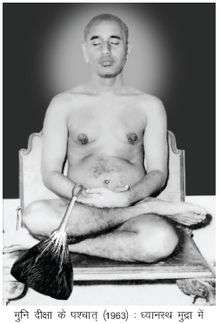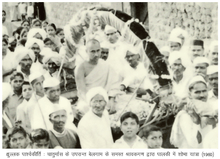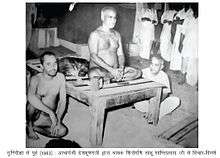Vidyananda
| Acharya Shri Vidyananda Ji Maharaj | |
|---|---|
 Muni Vidyananda (1963) | |
| Religion | Jainism |
| Sect | Digambara |
| Personal | |
| Born |
Shri Surendra Kumar Ji 22 April 1925 Shedbal, Karnataka |
| Parents |
|
| Religious career | |
| Predecessor | Acharya Deshbhushan |
| Initiation |
25 July 1963 Delhi by Acharya Deshbhushan |
| Part of a series on |
| Jainism |
|---|
 |
|
Jain prayers |
|
Ethics |
|
Major sects |
|
Festivals |
|
|
Acharya Vidyanand ji[1] (Hindi: आचार्य विद्यानंद) (Born 22 April 1925)[2] is one of the senior most principal thinker, philosopher, writer, composer, editor, curator[3] and a versatile Jain monk who has dedicated his entire life in preaching and practicing the noble concept of nonviolence (Ahimsa) through Jainism.[4][5] He is the disciple of Acharya Deshbhushan.[6] He has written may books and articles.[7] He is now about 90 years old. He has spent his past four chaturmas (4 months stay during the rainy season) in Delhi. Several institutions like D.J. Muni Vidyanand Shodhpith, Baraut, Uttar Pradesh are named after him. He has many monk disciples like Muni and lay disciples like Sahu Shanti Prasad Jain, Dr. Jay Kumarji Upadhye, a renowned Jain Scholar. Ahinsa Sthal in Delhi was established at the initiative of Acharya Vidyanandji on the land granted by the late Prime Minister, Rajiv Gandhi. Vidyanand was a notable figure in voicing the opinions of Digambara in the Bahubali affair.[8] There have been several distinguished Jain monks with the same name in history. One of whom is commentator of Tattvartha Sutra and Aptmimamsa, lived during 800 CE.
Early life
Born and brought up in a Jain family at Shedbal village in the southern state of Karnataka, India. His Primary education was in Marathi medium at Dhanwad Maharashtra and Higher education was in Kannada medium at Shedbal Karnataka but later he decided to Join Shanti Sagar Chatra Ashram in Shedbal for his higher studies in mastering multiple languages. After completing his initial education he got placed in Ordnance Factory in Pune by his uncles reference. After few months he finds it uncomfortable to contribute in manufacturing of any kind of weapons. So he quit that job and joined a Biscuit manufacturing factory in Pune. Unlike most of the youth in those days Surendera was also a strong believer that India's National freedom can only be achieved by Non-Violent movement and get inclined towards Nobel path of Ahimsa.This was the time when he had decided to dedicate his life towards spreading the concept in its root form as practiced in Jainism.
Initiation as Kshullaka
In the year 1945 at the age of 21, he came in touch with Acharya Mahavirkirti while he was practicing his annual Chaturmas at Shedbal. During this time he made a formal request to join his Jain Acharya Sangha. After a year of observation in the year 1946, Acharya Mahavirkirti initiated him as Kshulak Parshvakirti.

Starting from Kundapur in the year 1946 till 1962 at Shimoga he completed 17 chaturmas before being finally initiated as Muni Vidyanand by Acharya Deshbhushan in 1963. He had become so popular for his lectures and briefings on the Jain scriptures that his 15th Chaturmas in Belgam was celebrated with great enthusiasm and his followers sedan him in a palanquin on their shoulders and took him around the city to introduce him to the public in the year 1960.
Initiation as Muni
After strict practicing and following Jain Acharya Sangh's discipline for 17 years, He decided to get more intense with his course of becoming Jain monk by removing his worldly clothing symbolizing detachment and preserve the real soul for preaching the Noble concept of Ahimsa as the foundation of Jainism.

On 10 July 1963, he approached Acharya Deshbhushan ji at Chandni Chowk in Delhi who was heading the Jain Acharya Sangh at that time and made a formal request to initiate him as a Digambara monk or "Sky Clad Jain Monk". After several rounds of discussion he made his final request on 22 July 1963 and Acharya Deshbhushan ji announced that he will initiate him as Muni Vidyanand on 25 July 1963 and requested his sangh to make the necessary arrangements.
Thursday, July 25, 1963, A huge tent was erected at the Parade ground in Delhi with a center Stage to accommodate thousands of followers gathered to witness the historic event of Initiation of Muni Vidyananda. Soon after the introductory speech Acharya Deshbhushan ji initiated the ceremony and requested Khulak Parshvakirti to follow the instructions along with the holy chants. Parshvakirti followed the instructions and removed all the clothes and ornaments and threw them at the crowd to symbolize his detachment from the worldly matters and materials and initialize his journey as Digambara Muni Vidyananda.
Accession & Eminence
Shwet-Pichchhachary Vidyananda ji, 2010
He received eminence as Shwet-Pichchhachary after his international followers gifted him feathers of white peacock or Peafowl as soon as Government lifted the Ban on use of Peacock feather on July 24, 2010.
Acharya Vidyananda, 1987
28 June 1987 Delhi under Acharya Deshbhushan ji
Siddhant-Chakravarti Acharya Vidyananda, 1979
17 November 1979 Indore by (चतुः संघ) sangh
Elachary Vidyananda, 1978
17 November 1978 Delhi under Acharya Deshbhushan ji
Upadhyay Vidyanada, 1974
8 December 1974 Delhi under Acharya Deshbhushan ji
Muni Vidyanad, 1964
22 July 1963 Delhi under Acharya Deshbhushan ji
Kshullak Parshvakirti, 1946
15 April 1946 Tamadaddi, Karnataka under Acharya Mahavir Kirti ji
Chaturmas / Varshayog
As Kshulak Parshvakirti
- Konnur, Karnataka 1946
- Humcha, Karnataka 1947
- kumbhoj, Maharashtra 1948
- Shedbal, Karnataka 1949
- Shedbal, Karnataka 1950
- Shedbal, Karnataka 1951
- Shedbal, Karnataka 1952
- Shedbal, Karnataka 1953
- Shedbal, Karnataka 1954
- Shedbal, Karnataka 1955
- Shedbal, Karnataka 1956
- Humcha, Karnataka 1957
- Sujangarh, Rajasthan 1958
- Sujangarh, Rajasthan 1959
- Belgaum, Karnataka 1960
- Kundadri, Karnataka 1961
- Shimoga, Karnataka 1962
As Muni Vidyanand
- Lal Mandir, Delhi 1963
- Jaipur, Rajasthan 1964
- Firozabad, Uttar Pradesh 1965
- Samantbhadra Vidyalaya, Delhi 1966
- Meerut, Uttar Pradesh 1967
- Baraut, Uttar Pradesh 1968
- Saharanpur, Uttar Pradesh 1969
- Srinagar, Uttarakhand 1970
- Indore, Madhya Pradesh 1971
- Shri Mahavirji, Rajasthan 1972
- Meerut, Uttar Pradesh 1973
- Jain Balashram, Delhi 1974
As Upadhyay Vidyanada
- Jagadhri, Haryana 1975
- Chandni Chowk, Delhi 1976
- Baraut, Uttar Pradesh 1977
- Pahari Dhiraj, Delhi 1978
As Elachary Vidyananda
- Indore, Madhya Pradesh 1979
- Shravanabelagola, Karnataka 1980
- Shravanabelagola, Karnataka 1981[9]
- Kothli Shantigiri, Karnataka 1982
- Bahubali Kumbhoj, Maharashtra 1983
- Teen Murti, Borivali, Mumbai 1984
- GommatGiri, Indore 1985
- Kund Kund Bharti, New Delhi 1986
As Acharya Vidyananda
- Kund Kund Bharti, New Delhi 1987
- Kothli Shantigiri, Karnataka 1988
- Kothli Shantigiri, Karnataka 1989
- Baramati, Maharashtra 1990
- KundKund Bharti, New Delhi 1991
- KundKund Bharti, New Delhi 1992
- Greenpark, New Delhi 1993
- KundKund Bharti, New Delhi 1994
- KundKund Bharti, New Delhi 1995
- KundKund Bharti, New Delhi 1996
- Jaipur, Rajasthan 1997
- New Rohtak Rd, Delhi 1998[10]
- Greenpark, New Delhi 1999
- Jain Balashram, Delhi 2000
- Ahinsa Sthal, New Delhi 2001
- RK Puram, New Delhi 2002
- KundKund Bharti, New Delhi 2003
- KundKund Bharti, New Delhi 2004
- KundKund Bharti, New Delhi 2005
- KundKund Bharti, New Delhi 2006
- KundKund Bharti, New Delhi 2007
- Rishabh Vihar, New Delhi 2008[11]
- Greenpark, New Delhi 2009
- Greenpark, New Delhi 2010
- Greenpark, New Delhi 2011
- Greenpark, New Delhi 2012
- Greenpark, New Delhi 2013
- KundKund Bharti, New Delhi 2014
- KundKund Bharti, New Delhi 2015
- KundKund Bharti, New Delhi 2016
Panch Kalyanaka Pratishtha Mahotsava
- Bedkihal, Karnataka
- Buvnal, Maharashtra
- shravanabelagola, Karnataka
- Dharmasthala, Karnataka
- Bawangaja, Madhya Pradesh
- Gomat Giri, Indore
- Shamli, Uttar Pradesh
- Baraut, Uttar Pradesh
- Faridabad, Haryana
- Rishabh Vihar, Delhi
- Bahubali Enclave, Delhi
- Vasant Kunj, Delhi
- Vishwas Nagar, Delhi
- Vikas Puri, Delhi
- Shalimar Baugh, Delhi
- Greenpark, Delhi
- Najafgarh, Delhi
- Krishna Nagar, Delhi
- Kalkaji, Delhi
Achievements
- Production and distribution of Jain hymns gramophone records 1966-67.
- Renovation, conservation and perseverance of Shri Digambar Jain temple at Srinagar 1971.
- Creation of Jain iconography, Jain symbols including Jain flag composition 1974.
- Dharma Chakra Pravartan 1974.
- 2500th Nirvāṇa Mahotsava of Lord Mahavira 1974.
- Discussions with Acharya Tulsi (Jain monk) and Yuvacharya Mahāprajña[12]
- Production and distribution of audio cassettes of Samayasāra, DravyaSara and Cheh Dhala in the year 1976.
- Editing, composing and publication of Samayasāra and other scriptures 1977.
- Composing Samayasāra in form of musical hymn 1978.
- Laid the foundation of Kund Kund Bharti in New Delhi in the year 1978.
- Jan-Mangal Kalasha Parvartan 1980.
- Organizing Mahamastakabhisheka with sahastra shatabdi summit at Shravanabelagola in the year 1981.[13]
- Organizing Mahamastakabhisheka with Panch Kalyanaka of Lord Bahubali's 39 feet (12 m) high statue at Dharmasthala in the year 1982.[14]
- Peaceful protest against the illegal encroachment and mutual settlement of the historical dispute in Kumbhoj in the year 1983~84.
- Initiated the construction of mega statues of Lord Bahubali at Gommat Giri, Indore and Firozabad, Uttar Pradesh in the year 1986.
- Laid the foundation of Lord Bharata Meditation hall at Kund Kund Bharti, New Delhi in the year 1987.
- Inauguration of newly constructed building of Kund Kund Bharti, New Delhi in the year 1987.
- Organizing various programs under Acharya kundakunda 2000th annual summit in the year 1988.
- Restoration, conservation along with Mahamastakabhisheka of 84 feet tall Lord Adinatha's ancient statue located at Bawangaja in the year 1991.
- Since 1994 even before Jharkhand acquired Shikharji, leaving the rights of Jains in doubt. Acharya ji is actively monitoring and guiding the community and administration for a worthy resolution.
- Initiated formal courses to learn Prakrit at Shri Lal Bahadur Shastri Rashtriya Sanskrit Vidyapeetha in the year 1996.
- Organizing Mahamastakabhisheka of the Lord Mahavira statue at Shri Mahavirji in the year 1998.
- Laid the foundation of Kharavela Bhavana at Kundkund Bahrti, New Delhi in the year 1998.
- Organizing Mahamastakabhisheka of the Lord Mahavira statue at Ahinsa Sthal in the year 2001.
- Addressed interfaith conference organised by UNESCO on the subject "Culture of Peace and non-violence"[15] in the year 2001.
- Celebrated 131st birth anniversary of Charitra Chakravarti Acharya Shri Shantisagar ji as "Sanyam Varsha" in 2003.
- Laid foundation of a huge temple at the birthplace of Lord Mahavira located in Vasokund, Videhaya kundpur, Vaishali (ancient city), Bihar in the year 2004.
- Managing and organizing Mahamastakabhisheka at Shravanabelagola in the year 2006.
- Mahamastakabhisheka and Panch Kalyanaka of huge statue at Bharat Kshetra in Najafgarh, Delhi in the year 2006.
- Organizing Panch Kalyanaka Pratishtha Mahotsava with Elacharya ShrutSagar ji to install Lord Rishabha idol found during the excavation in 1991 Ranila village in Haryana in the year 2006.[16][17]
- Inauguration of "Ahimsa Paryavaran Sadhana Mandir" at New delhi with H.H. Dalai Lama[18] and Jagatguru Shankaracharya Swami Swaroopananda Saraswati Maharaj in the year 2007.[19]
- Organizing Mahamastakabhisheka of Lord Bahubali at Dharmasthala in the year 2007.
- Organizing Mahamastakabhisheka of Lord Adinatha's ancient statue located at Bawangaja in the year 2008.
- Mahamastakabhisheka and Panch Kalyanaka of huge statue of Lord Jambu Swami located at Mathura chaurasi, Uttar Pradesh with Elacharya ShrutSagar ji and Upadhyay VasuNandi ji in the year 2008.
- Laid the foundation of Kalap Katantra Pustakalaya[20] at Kund kund Bharti[21] in the year 2010.
- Initiation of Presidential Awards for the scholars of Prakrit.
Books and Articles
Most of the books, articles and editorials written by Acharya Vidyanand ji are in simplified Hindi though some of them use typical ancient Prakrit and Sanskrit shloka and sutra for references as mentioned in vedas and puranas. He is also mentoring scholars in their advance language studies with his translation skills.
References
- ↑ Acharya Shri 108 Vidyanand Ji Maharaj
- ↑ Studies in Jaina history and Culture: Disputes and Dialogues p. 352
- ↑ "Sravan".
- ↑ THE GENTLE CONQUERORS
- ↑ Jaina Iconography By Jyotindra Jain, Eberhard Fischer, Published 1978 BRILL
- ↑ Shri Acharyaratna Deshbhooshan Shikshan Prasarak Mandal's Mahavir Mahavidyalaya, Kolhapur, archived from the original on 20 June 2008
- ↑ Uban Retd. 1993.
- ↑ Carrithers & Humphrey 1991, p. 10.
- ↑ Nitin H.P. "Gallery - Category: Shravanabelagola - Indragiri - Image: Vidyananda cave, Acharya 108 Sri Vidyanandaji Maharaj did his meditation regularly in this cave during the 1981 Mahamasthakabhisheka.".
- ↑ "75th Birthday of Acharya Vidyananda".
- ↑ "Jainism Ahimsa News Religious Non-Violence Celebrities Literature Philosophy Matrimonial Institutions".
- ↑ "HereNow4U.net :: Books Online - Acharya Tulsi - Fifty Years Of Selfless Dedication - Glimpses Of Greatness - Acharya Tulsi & Celebrities - Acharya Shri Deshbhushan - Muni Vidyanandji". HereNow4u: Portal on Jainism and next level consciousness.
- ↑ "Ancient ritual of consecrating Bahubali gives Shravana Belgola a carnival look : Cover Story - India Today".
- ↑ "Mangalorean.com - Mangalore News Articles, Classifieds to Around the World".
- ↑ "Culture of Peace and Non-Violence". Culture of Peace and Non-Violence.
- ↑ "Jinvani – Shri 1008 Bhagwan Adinath Digambar Jain Atishay Kshetra, Ranila, Bhiwani Haryana".
- ↑ "on www.jainsamaj.org ( Jainism, Ahimsa News, Religion, Non-Violence, Culture, Vegetarianism, Meditation, India. )".
- ↑ The Office of His Holiness the 14th Dalai Lama. "News - The Office of His Holiness The Dalai Lama".
- ↑ "Resort to non violence to make world stronger: Saints". www.oneindia.com.
- ↑ "Kalap Katantra Pustakalaya". Wonobo.
- ↑ http://www.sdc.gov.in/Library/index.php?id=3
Bibliography
- Uban Retd., Maj. Gen. S.S. (1993). India Beyond Today & Tomorrow: Dialogues on the Future of India and Search for Alternatives. Allied Publishers.
- Carrithers, Michael; Humphrey, Caroline (1991). The Assembly of Listeners: Jains in Society. Cambridge University Press. ISBN 978-0-521-36505-5.
External links
- 2600th birth anniversary celebrations
- Passions of Nation & Community Bahubali Affair
- Audio Lectures at www.jainworld.com